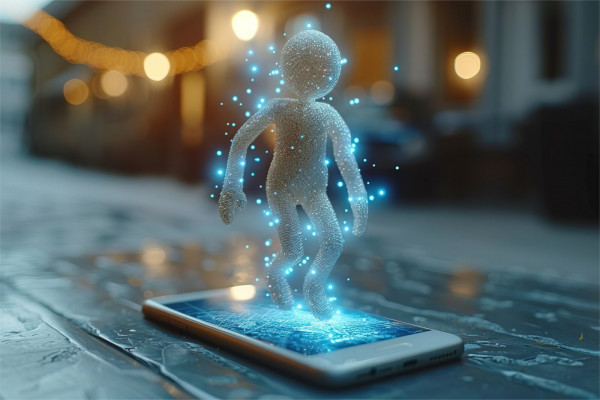Generative models are powerful tools that are being used to create increasingly realistic AI-generated faces. These models can learn from large datasets of images and then use that knowledge to generate new images that are similar to the ones they have seen.
Although generative AI models are still under development, but they have already made significant progress in creating realistic AI-generated faces. As these models continue to develop, they are likely to become even more powerful tools for creating visual content.
How Do Generative AI Models Create Faces
The process of generating AI-generated faces with generative models typically involves the following steps:
- Data collection: A large dataset of images of human faces is collected. This dataset should be as diverse as possible, including images of people of different ages, genders, races, and ethnicities.
- Data preprocessing: As the next step in creating AI-generated faces, the images in the dataset are preprocessed to ensure that they are all of the same size and format. This is important so that the generative model can learn from the data effectively.
- Model training: The generative model is trained on the preprocessed data. This process involves feeding the model the images in the dataset and allowing it to learn the patterns and relationships between the pixels in the images.
- Image generation: Once the model has been trained, it can be used to generate new images of human faces. This is done by providing the model with a seed image or a set of parameters that describe the desired image.
The current state of AI-generated faces is rapidly evolving, with advancements being made in both realism and versatility. Generative adversarial networks (GANs) have played a pivotal role in this progress, enabling the creation of incredibly lifelike faces that can often be indistinguishable from real ones.
Realism of AI-Generated Faces
The realism of AI-generated faces has reached an impressive level, with some models capable of producing images that are nearly identical to photographs of real people. These synthetic faces exhibit intricate details, such as subtle skin textures, hair strands, and even the micro-expressions that convey emotion.
Some notable achievements in AI-generated faces include:
- GANimation: This technique allows for the animation of AI-generated faces, enabling the creation of realistic facial expressions and movements.
- StyleGAN2: This model introduced a new approach to GAN training, resulting in the generation of highly diverse and realistic facial features.
- StyleGAN-ADA: This model further enhanced the realism of AI-generated faces, particularly in capturing the subtle variations in facial expressions and emotions.
- AI-Generated Faces with Attributes: GANs have also been used to generate faces with specific attributes, such as age, gender, ethnicity, and hairstyle.
- AI-Generated Faces from Text Descriptions: Recent research has explored the possibility of generating faces from text descriptions, allowing for the creation of faces based on verbal prompts.
Despite the remarkable progress, challenges remain in creating AI-generated faces that are truly indistinguishable from real ones. Subtle imperfections, such as inconsistencies in lighting, skin texture, and hair rendering, can still reveal the synthetic nature of the images.
Use Cases of AI-generated Faces for Visual Content
AI-generated faces are having a significant impact on industries like film, advertising, and gaming, offering creators new possibilities for visual storytelling and character development. Here’s a closer look at their influence in each industry:
Film
AI-generated faces can reduce production costs by eliminating the need for hiring actors and makeup artists for certain roles, particularly background characters or crowd scenes. AI can create realistic digital doubles of actors for scenes that require aging or special effects, saving time and money on makeup and prosthetics. AI-generated faces can also be used to create virtual stunt doubles for dangerous or physically demanding action sequences, enhancing safety and reducing the risk of injuries.
Advertising
AI can generate diverse and personalized facial representations for targeted advertising campaigns, increasing relevance and engagement. In addition, AI-generated faces can convey a wide range of emotions and expressions, enhancing the storytelling power of advertisements. AI can also create virtual spokespersons or influencers with tailored personalities and appearances, expanding marketing reach and appeal.
Gaming
AI can generate highly realistic facial models for video game characters, enhancing immersion and player engagement. AI can create a vast array of unique and diverse NPCs (non-player characters) for open-world games, adding realism and replayability. AI can enable more dynamic and emotionally responsive interactions between players and NPCs, enhancing the gaming experience.
As AI-generated faces become increasingly realistic, it’s crucial to consider the ethical implications of this technology. Here are some key ethical considerations and potential misuses that need to be addressed:
Potential Misuses
If there are helpful applications of AI-generated faces, there are possibilities of exploitation by cybercriminals as well.
- Deepfakes for Propaganda or Disinformation – AI-generated faces could be used to create deepfakes of politicians, celebrities, or other public figures, spreading misinformation or propaganda to influence public opinion or disrupt elections.
- Fake Profiles and Social Media Manipulation – They could be used to create fake social media profiles, engage in catfishing, or manipulate online interactions for malicious purposes.
- Non-Consensual Intimate Image Generation – AI-generated faces could be used to create non-consensual intimate images, also known as “revenge porn,” causing psychological harm and violating individuals’ privacy.
- Identity Theft and Financial Fraud – Cybercriminals can also create fake identities for financial fraud, such as opening bank accounts or applying for loans under false pretenses using AI-generated faces.
How to Mitigate Ethical Issues
As the AI-driven content creation landscape becomes more complex to navigate, here are some ways we can mitigate the ethical issues that could arise due to the technology’s proliferated usage.
Ensuring that AI models are trained on diverse and representative datasets can minimize bias and promote fairness. Implementing mechanisms to watermark or make AI-generated faces traceable can help identify and combat deepfakes or misuse.
Educating the public about AI-generated faces, their capabilities, and potential misuses will help promote responsible use and prevent misuse. One of the most effective and urgent steps would be establishing clear regulations and oversight frameworks to govern the development and use of AI-generated faces, ensuring ethical and responsible practices.
To Wrap Up This Discussion
The only way now is forward when it comes to generative AI models and content creation using AI-generated faces. However, responsible usage is of paramount importance if we are to leverage modern AI technologies while ensuring the privacy of all the stakeholders of the new world. AI-generated faces and their applications will only grow, and it’s up to the people who use them to use them the right way.
STL Digital’s experts are well-versed in generative AI technologies and can help you take advantage of the latest AI tech without crossing any boundaries not meant to be crossed.



